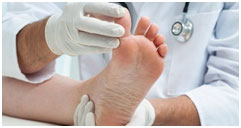The Problem:

Internationally, over 250,000,000 adults currently have diabetic peripheral neuropathy. Diabetic peripheral neuropathy is a type of nerve damage that can occur if you have diabetes. High blood sugar (glucose) can injure nerves throughout the body. Diabetic neuropathy most often damages nerves in the legs and feet, causing tingling and numbness.
The exact cause of each type of diabetic neuropathy is unknown. Researchers believe that over time, uncontrolled high blood sugar damages nerves and interferes with their ability to send signals, leading to diabetic neuropathy. High blood sugar also weakens the walls of the small blood vessels (capillaries) that supply the nerves with oxygen and nutrients. This nerve damage can cause a loss of feeling in the feet, so even minor cuts can turn into sores or ulcers without being noticed. In many cases, an infection can spread to the bone or lead to tissue death. Removal (amputation) of a toe, foot or even part of the leg may be necessary.
Diabetic Foot Ulcerations (DFU) are the most common complication of diabetes and the leading cause of hospitalization in patients with diabetes. Every 0.1 seconds, someone is diagnosed with a DFU. Over 60% of foot ulcers become infected, requiring hospitalization. These foot complications affect 40 million – 60 million people annually, resulting in a lower extremity amputation every 30 seconds. 80% of diabetes-related lower limb amputations are preceded by a DFU. Every year, over 1 million people with diabetes lose a lower limb. DFUs cost the U.S. healthcare system over $15Billion per year.
Patients with diabetic neuropathy are at a greater risk of developing a DFU because they have lost all or part of the feeling in their feet.
Proper daily foot monitoring and care can reduce foot ulcer incidences by up to 80%,which leads to a 45% to 85% reduction in foot amputations. Therefore, The American Diabetes Association (ADA) recommends checking your feet every day, looking for blisters, cuts, bruises, cracked and peeling skin, redness, and swelling.
However, in a recent study in Diabetes Care, it was found that only 6% of Diabetic patients practice proper foot care. WHY???Because it is harder for them than it appears…
The Challenges:
Eye problems, arthritis, obesity, and age limit the patient’s ability to perform daily visual inspections and prevents the improvement of these visual inspection rates.
Diabetes is the leading cause of blindness (retinopathy), affecting over 40 million adults. These patients have trouble seeing and cannot visually inspect the bottom of their feet.
Almost half of all diabetic patients also have arthritis. It is difficult and painful for them to stretch and flex their legs for a proper inspection.
Approximately 80% of people with diabetes have weight problems (obesity). Some of these patients have trouble bending down and cannot physically reach the bottom of their feet.
25% of diabetic patients are over the age of 65. Many seniors have limited mobility and other health concerns which restrict them from performing a daily foot inspection.
Remember, many of these patients cannot feel the bottom of their feet, so they are unaware if/when an ulcer is beginning to form. They do not feel the extreme pain because of the numbness caused by the peripheral neuropathy.
The Center for Disease Control and Prevention (CDC), has provided tips for proper foot care:
Check your feet every day for cuts, redness, swelling, sores, blisters, corns, calluses, or any other change to the skin or nails. Use a mirror if you can’t see the bottom of your feet or ask a family member to help.
Wash your feet every day in warm (not hot) water. Don’t soak your feet. Dry your feet completely and apply lotion to the top and bottom—but not between your toes, which could lead to infection.
Never go barefoot. Always wear shoes and socks or slippers, even inside, to avoid injury. Check that there aren’t any pebbles or other objects inside your shoes and that the lining is smooth.
Wear shoes that fit well. For the best fit, try on new shoes at the end of the day when your feet tend to be largest. Break in your new shoes slowly—wear them for an hour or two a day at first until they’re completely comfortable. Always wear socks with your shoes.
Trim your toenails straight across and gently smooth any sharp edges with a nail file. Have your foot doctor (podiatrist) trim your toenails if you can’t see or reach your feet.
Don’t remove corns or calluses yourself, and especially don’t use over-the-counter products to remove them—they could burn your skin.
Get your feet checked at every health care visit. Also, visit your foot doctor every year (more often if you have nerve damage) for a complete exam, which will include checking for feeling and blood flow in your feet.
Keep the blood flowing. Put your feet up when you’re sitting and wiggle your toes for a few minutes several times throughout the day.
Choose feet-friendly activities like walking, riding a bike, or swimming. Check with your doctor about which activities are best for you and any you should avoid.
According to the International Diabetes Federation, approximately 537 million adults (20-79 years) are currently living with diabetes.The total number of people living with diabetes is projected to rise to 643 million by 2030 and 783 million by 2045.
Given both the complications of detecting and addressing diabetic foot ulcers, alternative approaches are needed to help diabetic patients address this potentially life threatening and life altering condition.
Carl Marshbanks, MBA is the CEO for XtremedX LLC., a medical device company located in Greenville, SC. XtremedX is currently working on a new insole device to early detect Diabetic Foot Ulcerations and is committed to finding a solution for this increasing problem.



















